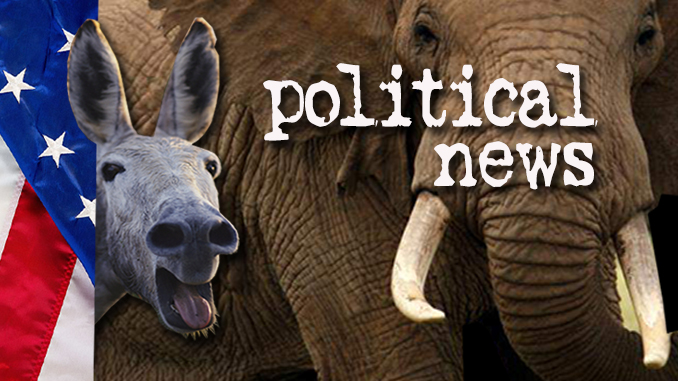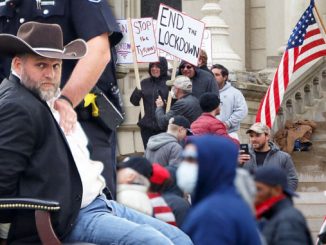
Woodrow Wilson, Donald Trump, the Spanish Flu, and Covid-19.
By S.T. Patrick
By the time the 1918 influenza pandemic (Spanish Flu) had finished unleashing its wrath upon the population of the world, it had infected about 500 million of the world’s population. One in three had contracted the virus. The death toll had risen to around 50 million globally, with over 675,000 deaths in the U.S. alone. It had been one of the worst viral outbreaks since the Black Plague had killed one-third of Europe’s population in the 17th century. As Covid-19 now enters its second calendar year, comparisons are being made to the Spanish Flu, politically.
President Woodrow Wilson was hit with a debilitating stroke in 1919 that left him unable to conduct, clearly and effectively, the daily duties of the executive office. His wife Edith, and his physician Dr. Cary Grayson served as gatekeepers, deciding what Wilson could do in the day, with whom he could communicate, and even what documents he would read. This has caused some overzealous historians to call Mrs. Wilson “the first female president of the United States.” Historians also believe Wilson had been affected by the flu pandemic in 1919, which had caused his severe illness at the Paris Peace Conference.
Before Wilson had become bed-ridden from the stroke, he had pushed for a fair and just resolution to World War I, a war in which he had enthusiastically engaged. As Abraham Lincoln prioritized preinclusion as the backbone of his reconstruction plan, Wilson sided with those who wanted reconciliation with the Central Powers and Germany rather than severe punishment. This changed after his stroke. Herbert Hoover was at the Paris meetings and stated that Wilson had been “incisive and quick to grab essentials . . . willing to take advice.” After the stroke, Hoover compared dealing with Wilson to “pushing against an unwilling mind.” Wilson then capitulated to the extremists, and Germany was severely punished by the final Versailles Treaty. Wilson had changed and had become more irascible after his illness.
President Donald Trump and wife Melania tested positive for Covid-19 at the beginning of October. The president was given emergency treatment at Walter Reed Army Medical Hospital. Some medical analysts have cited this as the reason Trump’s naturally volatile temperament turned even more explosive in October and November. They claim it was the neurological effects of either Covid-19 or his treatment at Walter Reed. In both Wilson and Trump’s cases, there was talk of enacting the 25th Amendment to the Constitution, which allows temporary removal from decision making authority if some level of incapacitation can be proven. Also, in both cases, nothing came of the talk.
From a liberal historian’s point of view, Mr. Trump’s behavior after the October illness seems extreme, even for him. Making the case that something, neurologically or mentally, happened to Mr. Trump at the time of his illness, Robert Brent Toplin wrote, “The president’s actions after his episode with the coronavirus were extraordinary. Following release from the hospital, Trump demanded the Justice Department lock up Joe Biden, Barack Obama, and Hillary Clinton. He lambasted loyal allies, including Mitch McConnell, Mark Meadows, and William Barr. Mr. Trump refused to accept defeat and made unsubstantiated claims about fraudulent ballots. He alarmed aides by considering recommendations to declare martial law, seize voting machines, and appoint a conspiracy theorist as special prosecutor. And, on Jan. 6, the president [allegedly] incited a mob to attack the U.S. Capitol as a joint session of Congress worked to ratify the Electoral College vote and formalize his defeat.”
While many disagree with many of the assumptions made in Toplin’s assessment, he isn’t alone in his assessment of Trump’s behavior following coronavirus treatment, and neither was Herbert Hoover in his post-illness assessment of Wilson.
There are differences, of course. Some of the greatest ideological wars over masking in 1918 occurred in San Francisco, Calif., which, today, is the natural hub for the most stringent pro-masking regulations of California Gov. Gavin Newsom. The backbone of anti-masking pro-Trump support is the Midwest and the South.
Wilson’s malady came on quickly. On April 3, 1919, he came down with a horrendous cough that deteriorated rapidly. The Spanish Flu allowed its victims little time. It was common for someone to recognize their first symptoms in the morning and die in the evening. Some would go to the doctor immediately and die waiting to see him. Wilson’s Dr. Grayson would later describe the incredibly long evening at Wilson’s bedside as, “one of the worst through which I have ever passed. I was able to control the spasms of coughing, but his condition looked very serious.”
Spain’s King Alfonso XIII contracted the Spanish Flu; Great Britain’s Boris Johnson contracted Covid-19. Both pandemics affected everyone from paupers to presidents and kids to kings.
John Berry, the author of The Great Influenza: The Story of the Deadliest Pandemic in History, wrote, “Even after their burning fevers subsided, flu victims described ‘post-influenzal manifestations,’ psychotic delusions and visions that resulted from damage to the nervous system.”
According to the Harvard Medical School, “Specific neurological symptoms seen in people with Covid-19 include loss of smell, inability to taste, muscle weakness, tingling or numbness in the hands and feet, dizziness, confusion, delirium, seizures, and stroke.”

The political treatment of the Covid-19 pandemic has already changed since Joe Biden has taken office. Democrats are cheering the proactive approach Mr. Biden has promised, while many Republicans, still skeptical about the disease’s severity, believed the pandemic would suddenly cease shortly after Joe Biden was sworn in. This has already been an interesting year. More will come.
S.T. Patrick holds degrees in both journalism and social studies education. He spent 10 years as an educator and now hosts the “Midnight Writer News Show.” His email is [email protected]. He is also an occasional contributor to TBR history magazine and the current managing editor of Deep Truth Journal (DTJ), a new conspiracy-focused publication available from the AFP Online Store.






